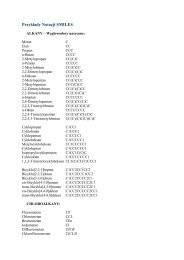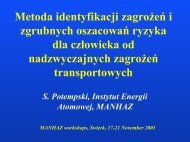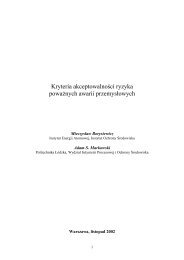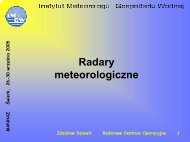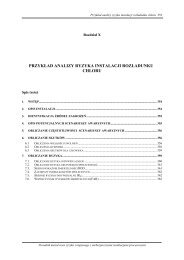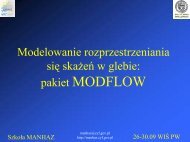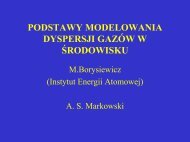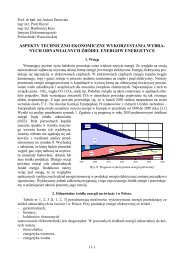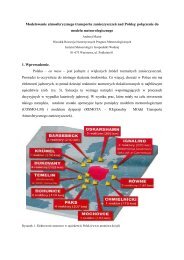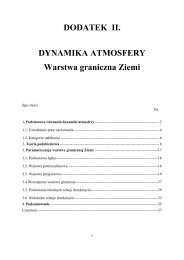Modelling of Pollutant Transport in the Atmosphere - MANHAZ
Modelling of Pollutant Transport in the Atmosphere - MANHAZ
Modelling of Pollutant Transport in the Atmosphere - MANHAZ
Create successful ePaper yourself
Turn your PDF publications into a flip-book with our unique Google optimized e-Paper software.
(e.g. by follow<strong>in</strong>g a small neutrally buoyant balloon), while Eulerian<br />
properties imply that e.g. w<strong>in</strong>d statistics that can be obta<strong>in</strong>ed from<br />
simpler measurements at a fixed po<strong>in</strong>ts (e.g. at <strong>the</strong> release po<strong>in</strong>t or from<br />
a Met tower).<br />
Five years later F. L. Richardson (1926) presented results from his<br />
observations on "relative atmospheric diffusion". He showed, on a<br />
distance-neighbor graph, that two-particle's relative separation on<br />
average scaled with <strong>the</strong> particles <strong>in</strong>stantaneous separation. This<br />
observation later led him to formulate his famous “Diffusivity for<br />
relative dispersion α l 4/3 power law ” , where l is <strong>the</strong> two particles'<br />
<strong>in</strong>stantaneous separation.<br />
Ano<strong>the</strong>r British scientist, G. K. Batchelor (1952), related relative<br />
dispersion directly to scal<strong>in</strong>g parameters for <strong>the</strong> turbulence itself, which<br />
has meanwhile been discovered by Russian scientists (an example <strong>of</strong> a<br />
turbulence scal<strong>in</strong>g parameter is for <strong>in</strong>stance <strong>the</strong> Kolmogorov's <strong>in</strong>ertial<br />
subrange dissipation rate ε). In his famous article "Diffusion <strong>in</strong> <strong>the</strong> Field<br />
<strong>of</strong> Homogeneous Turbulence, II. The relative motion <strong>of</strong> particles" G. K.<br />
Batchelor relates <strong>the</strong> standard deviation for a puff to <strong>the</strong> dissipation<br />
rate ε for homogeneous 3-dimensional <strong>in</strong>ertial subrange turbulence (σ 2 y α<br />
εT 3 ).<br />
Ad 3. Lagrangian Similarity Theory (Scal<strong>in</strong>g)<br />
The Lagrangian similarity approach. Similarities scal<strong>in</strong>g <strong>of</strong> turbulence<br />
means that <strong>the</strong> vertical pr<strong>of</strong>iles <strong>of</strong> <strong>the</strong> state quantities (such as<br />
temperature, w<strong>in</strong>d speed, humidity, pollutants etc) are uniquely<br />
determ<strong>in</strong>ed by <strong>the</strong> so-called scal<strong>in</strong>g parameters, which are: height z above<br />
<strong>the</strong> ground, air density ρ, buoyancy parameter g/T, surface shear stress<br />
u*, and <strong>the</strong> vertical flux <strong>of</strong> heat H/cpρ. The prerequisites for similarity<br />
scal<strong>in</strong>g to apply is that <strong>the</strong> turbulence is homogeneous and stationary, and<br />
that <strong>the</strong> vertical fluxes <strong>of</strong> momentum - ρu*<br />
2 and heat H/cpρ are constant<br />
<strong>in</strong>dependent <strong>of</strong> height. These assumptions can <strong>of</strong>ten be fulfilled <strong>in</strong> <strong>the</strong><br />
Planetary Surface Layer (PSL). The orig<strong>in</strong>s <strong>of</strong> similarity scal<strong>in</strong>g for <strong>the</strong><br />
atmospheric surface layer turbulence has roots <strong>in</strong> early work by Russian<br />
academicians Mon<strong>in</strong> and Obukhov, who formed <strong>the</strong> similarity based Mon<strong>in</strong>-<br />
Obukhov stability parameter "L", see below.<br />
18



